Stone, minerals and semiprecious of the world stone
Chlorites (silicates): Chrysocolla -->rus
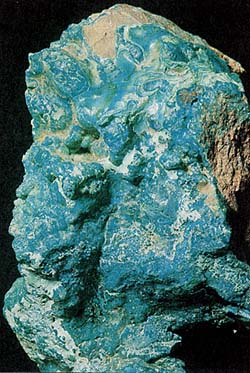 Diagnostic cart.
Diagnostic cart.
On a photo is concretionary mass of chrysocolla. Down: microcrystalline aggregate of chrysocolla, consisting of globule (an island Elba).
Cu2 H2 Si2 O5 (OH)4 * n Н2О
Crystal structure rhombic or monoclinic
Hardness on the Mohs scale 2-4
Specific unit weight mass 2-2,4
Cleavage non-existent
Fracture, break padman
Colors bluish (cyan) -green
Colors in powder triturate greenish-white
Glance (glitter, glare) from glass to waxen
A chrysocolla is amorphous mixture of different silicates of copper and aquated silica mostly, containing various admixtures, such as an alumina, oxides coppers and Limonite. On these reasons typical a bluish (cyan) -blue color of mineral can be more dark, up to passing to brown. Be found as dense concretions, rarer as massive cryptocrystalline accumulations with a thin radiant or globule structure, sometimes there are microscopic needle-shaped crystals. Glance (glitter, glare) at translucent aggregates earthy and waxen, up to glass, conditioned more high maintenance of silica.
Green or blue color, in presence the oxides of iron and copper colouring changes to brown and black. The published information on a chrysocolla is partly contradictory, and it is possible justly to consider that authentic nature of this mineral is not set. Maintenance of water is inconstant in any case. Habitus. As crystals does not meet, usually is in very thin-fibrous or massive, and on occasion in earthy the masses.
Crystal structure, class of symmetry, spatial group. A chrysocolla is described variously: as amorphous with Si4O10- layer stratum, present in an imperfect structure (and attribute it to the stratified silicates), as cryptocrystalline either with unknown or with rhombic Crystal structure (in last case it is attributed to the tectosilicates), as monoclinic (without attributing to some group of silicates) and as mixture of colloid plansheite, Cu8 Si8 O22 (OH) 4 * H2O, and shatukite, Su5(SiO3) 4(OH).
In olden times turquoise quite often was replaced the no less bright painted mineral of blue color - chrysocolla. From the chemical point of view this stone is the water silicate of copper which gives a stone a dark blue color. Term a "chrysocolla" has a very ancient origin. So this mineral named in IV century B.C. Feofrast.
It other age-old name - elate stone - a chrysocolla got on the mines of tsar of Solomon (Israel), to located near the bay of Elat in the Red sea and of the same name city, where it in olden times was obtained in handsome amounts. It is thus necessary will make a reservation, that elate stone is a not chrysocolla in a clean kind, but only veins of this mineral in light sandstones. Stone of good happy cheerful mood.
Diagnostic indication.
Unlike turquoise which it is often accepted for, a chrysocolla at immersion in muriatic acid forms a rather yellow raid on-the-spot. Green Chrysocolla looks like malachite, but at operating on it HCl bubbles are not selected.
Origin provenance genesis.
A mineral be found mainly in superficial part of area of oxidization of copper-ore deposits and formed initially as gel, containing a silica, water and copper.
Deposit minefield mine field occurrence subsoil.
Widely widespread in the world, a chrysocolla in large accumulations be found in Chile, United States, Zaire, Folk Republic Congo, Great Britain and Russia. In Italy found out a chrysocolla on the edges of glacier of Predarossa, in Val'-mazino (province of Sondrio), Kampil'ya-maritima (province of Livorno), in the mountains of Monconi in Val'-di-fassa (province of Trento). In our time the deposits of chrysocolla are known on Ural (CIS), in Kazakhstan (CIS), in the USA, Zaire, Chile.
Use, practical application, deployment.
A chrysocolla is used on jeweller business; mainly it is exposed to cutting in pebbles and cabochon.
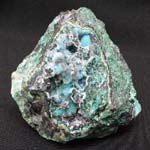
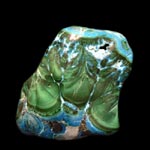
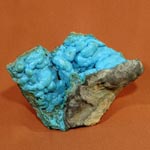
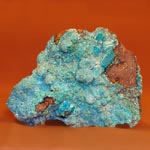
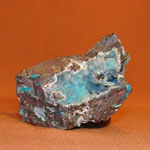
Widespread in Chile, CIS (Ural), USA (state is Arizona, Nevada), Zaire (Shaba). Entangling a chrysocolla is possible with blue chalcedony, turquoise, Variscite. Chrysocolla quartz name accretions of chrysocolla and quartz sometimes, and elate stone are accretions of chrysocolla with turquoise and malachite.
Phosphates: Variscite, Shtrengite -->rus
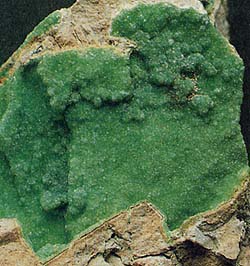 Diagnostic card.
Diagnostic card.
There is a standard of Variscite on a photo. Down: spheroidal aggregates of Shtrengite.
Fe PO4 * 2 H2O - Variscite (green)
Al PO4 * 2 H2O - Shtrengite (blue)
Singoniya rhombic
Hardness 4-5
Specific gravity 2,52
Cleavage is perfect
A fracture is a padman, fragile
A color is green
A color in the sprinkle of snow is white
Brilliance is glass, waxen (information for variscita)

 These two names are used for the initial and eventual members of isomorphous row, crystallizable in the rhombic system. Variscite forms octahedral crystals. But massive accumulations, veins or tumours, are more widespread. Their color varies from a primrose to emerald green. By the tints of the color which varies from apple-green to yellow and blue, this semilucent mineral is under an obligation the admixtures of connections of iron and chlorine.
These two names are used for the initial and eventual members of isomorphous row, crystallizable in the rhombic system. Variscite forms octahedral crystals. But massive accumulations, veins or tumours, are more widespread. Their color varies from a primrose to emerald green. By the tints of the color which varies from apple-green to yellow and blue, this semilucent mineral is under an obligation the admixtures of connections of iron and chlorine.
Variscite - it a mineral, water phosphate of aluminium, meets as pseudooctahedral crystals and short-grained kidney-shaped, reniform, nephroid aggregates. In the Mineralogical museum of the name of A. E. Fersmane the polished cut of stone, delivered from the United States of America is kept Russian Academy of Sciences. He reminds the green-sky-blue smooth surface of warm tropical waters the color. It is a standard of water phosphate of aluminium - Variscite, adopted so on one of districts of Saksoniya - Varisciya. Opening of Variscite took a place in 1837. In 1894 were found out the standards of green variscita, accrete with kvarcem, in the state of Quarter-deck (USA). A green secondary mineral consisting of hydrated aluminium phosphate. Possible psevdomorfoza on fossils (kosti skulls and cerebrum and other).
Shtrengite is presented the crystals of changeable form (by pseudooctahedrons, tablets, prisms) or forms the aggregates of spheroidal outlines with a fibred-radiant internal structure, painted in carminic-red and violet colors. The monoklinnym analogue of shtrengita is clinoshtrengit, formative the tablitchatye crystals of peachy-red or violet color; he also meets as small massive accumulations or including of earthy structure, painted in a rose-red color.
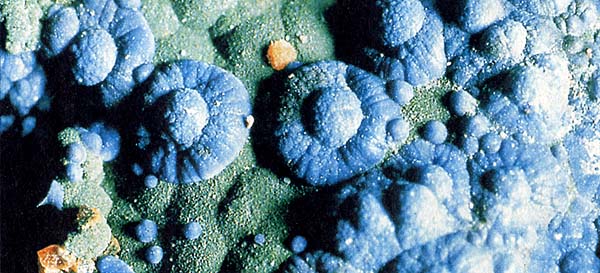
Diagnostic indication.
Rastvorimy in acids at heating. Refractory.
Origin provenance genesis.
Shtrengite meets in cracks and emptinesses of siltages (especially including the minerals of iron). He can be also formed at the second changes of other phosphates in the roof of ore deposits. Variscit is in veins and cracks among quartzitic slates and quartzites.
Deposit minefield mine field occurrence subsoil.
About shtrengite reported from the mine of Grube-Eleonora in Tyuringii, from pegmatites of deposit of Nagendorf in Bavaria, from Mangualde in Portugal, from the district of Rokbridzh in the state of Virginium, Palermo in the state of New-Khempshir. Klinoshtrengit is known from Bavaria, N'yu-khempshira and from Colombia. In Italy he is described in the mine of San-dzhiovannedu on Sardinia, in an association with a violet anglesite. Variscit is marked in different places (Saksoniya, Austria and Bohemia). The deposit of Feyrfild is most widely known in the state of Quarter-deck (USA). The American deposits of variscita are fully mined-out presently. Operating while a source of variscita is territory of Australia. Found out variscity also in Germanium and Brazil.
Polished and polished Variscite is used as a carpentry stone, reminding turquoise. On jeweller business variscit was used as a carpentry stone as a substitute of turquoise as kaboshonov. Variscit usually use for making different pendants and coulombs. Make out of pieces of variscita and beads, and with variscitom will meet a ring unoften. Down on a photo green variscit.
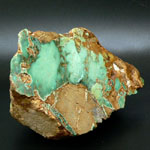
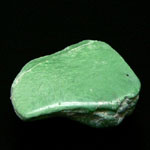

Sometimes Utahlite (USA) is examined as an independent mineral (but not synonym of variscite). Deposits are known in the USA (st. Utah and Nevada) and Australia (Queensland). Entangling this mineral is possible with a chrysocolla, chrysoprase, turquoise. Germinating variscitom quartz or chalcedony from sht. Utah (USA) amatriksom or variscitovym kvarcem name.
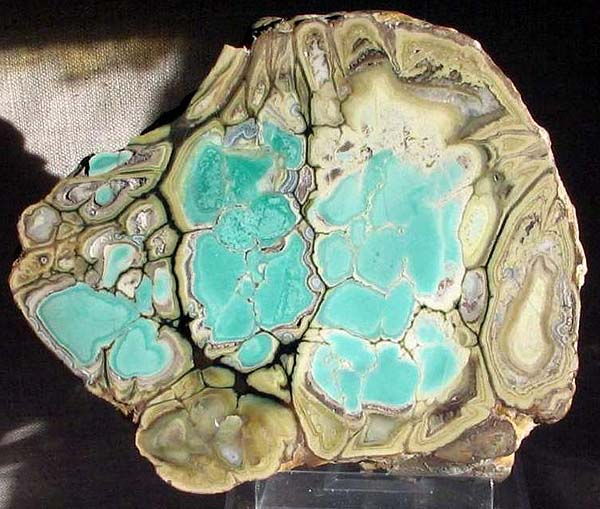
Variscite. Montgomeri of neighbourhoods, Arkansas, USA. Photo: © A.A. Evseev.
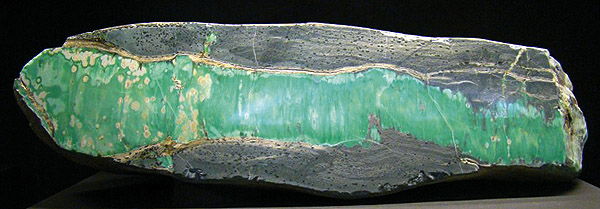
Variscite (green). Australia. Album of photo (2011).
